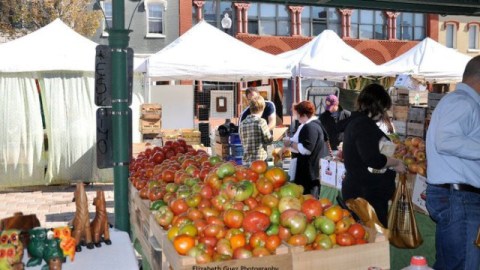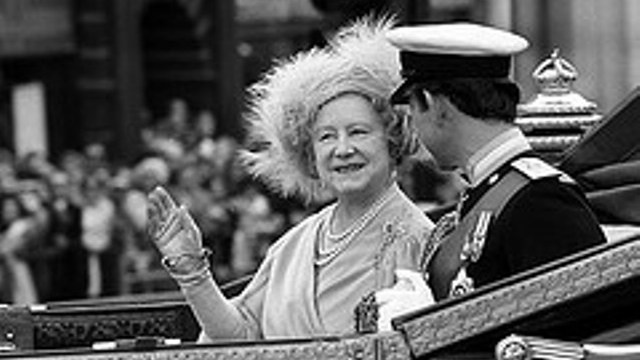Are Washington, D.C. Farmers Markets a Solution to the City’s Food Deserts?

Farmers markets are wildly popular among the urban elite in Washington, D.C. and other urban areas across the country. In a guest post today, Melissa Winn considers efforts to expand farmers markets into low income areas of the city, increasing the availability of affordable produce and other healthy choices. Winn is an undergraduate student in this semesters “Science, the Environment and the Media” course at American University — Matthew C. Nisbet.
Looking for a healthy, less costly alternative to high-end organic markets? Washington, D.C. is home to a vast number of farmers markets, large and small. Browse through the colorful rows of fruits, vegetables, meats and preserves that allow for an organic, pesticide-free alternative to eating. Farmers markets were first introduced in the 1970’s during the height of the environmental movement in California. Spanning from a simple concept that allowed farmers the opportunity to travel into larger cities to sell their products, farmers markets have since reached all corners of the United States.
Just for the Urban Elite?
With the support of Michelle Obama, farmers markets have become the latest trend. The Department of Agriculture notes that farmers markets are on the rise, with the number of markets jumping 16 percent in 2010. Currently, there are 6,132 farmers markets operating nationwide, with 28 of those residing within the District of Columbia. The Department of Agriculture states that the growing attraction to farmers markets has been propelled by concerns for food safety and a renewed focus on healthy eating.
Although some researchers believe farmers markets are proof of a strong local food system, researchers at Franklin and Marshall College recently released a study suggesting that it is largely wealthier urbanites that benefit from farmers markets. The USDA reports that more than 50 percent of Americans do not consume the recommended five servings of produce a day, with low-income populations consuming the least. With few food retail outlets selling fresh produce in low-income neighborhoods, farmers markets have been promoted as a possible solution what experts call “food deserts.”
Yet, currently few farmers’ markets operate in low-income areas of Washington, D.C. Only four of the city’s farmers’ markets are located east of the Anacostia River in Wards 7 and 8 (dchunger.org). To combat this geographical imbalance, fifteen farmers markets in D.C. now accept food stamps (see below). These initiatives are trying to shiftfarmers markets beyond just the urban elite. Recently, the Wholesome Wave Foundation Double value Coupon Initiative partnered with select FreshFarmsMarkets to double the value of food stamps at participating markets. The goal is to increase the flow of healthy food to low-income DC residents.
Farmers Markets within the District of Columbia
** Wholesome Wave Foundation Double Coupon participant.
$ Accepts Food Stamps.
ADAMS MORGAN FARMERS MARKET ($) Columbia Road and 18th Street NW May 1-Dec. 18, Saturdays, 8 a.m.-2 p.m.
ANACOSTIA FARMERS MARKET 14th Street between U and V streets SE June 2-Nov. 17, Wednesdays, 3 p.m.-7 p.m.
BLOOMINGDALES FARMERS MARKET ($) First and R Streets NW June 17- Nov. 18, Sundays 10a.m. – 2p.m.
CHEVY CHASE FARMERS MARKET Lafayette Elementary School, May 1-Nov. 27, Saturdays, 9 a.m.-1 p.m.
COLUMBIA HEIGHTS COMMUNITY MARKETPLACE ($) 14th and Irving streets NW May 15-Oct. 30, Saturdays, 8:30 a.m.-1:30 p.m.
D.C. FARMERS MARKET 1309 Fifth St. NE Year-round, Tuesdays through Thursdays, 7 a.m.-5:30 p.m. Fridays and Saturdays, 7 a.m.-6:30 p.m. Sundays, 7 a.m.-2 p.m.
EASTERN MARKET OUTDOOR FARMERS MARKETSeventh Street between C Street and North Carolina Avenue Year-round, Saturdays and Sundays, 7 a.m. to 4 p.m.
DUPONT CIRCLE FRESHFARM MARKET 1500 block of 20th St. NW between Q Street and Massachusetts Avenue NW Year-round, Sundays, March 28-Jan. 2, 9 a.m.-1 p.m.; Jan. 9-March 20, 10 a.m. -1 p.m.
FOURTEENTH AND U STREETS FARMERS MARKET ($) 14th and U streets June 2-Oct. 27, Wednesdays, 4-8 p.m.
GEORGETOWN FRESHFARM MARKETHyde Elementary School May 8-Oct.30, Saturdays, 9 a.m.-1 p.m.
GEORGETOWN MARKET IN ROSE PARK 26th and O streets NW April 14-Oct. 20, Wednesdays, 4-7 p.m.
H STREET FRESHFARM MARKET** ($) 600 block of H St. NE June 5-Oct. 30, Saturdays, 9 a.m. -1 p.m.
FRESHFARM MARKETS, HEALTH AND HUMAN SERVICES** 200 Independence Ave. SW May 18 – Oct. 26, Wednesdays, 11 a.m. – 2p.m.
HERITAGE PARK FARM STAND Division Avenue and Foote Street NE May 15-Oct. 30, Saturdays, 9 a.m.-1 p.m.
HISTORIC BROOKLAND FARMERS MARKET 10th and Otis streets NE May 30-Oct.31, Sundays, 10 a.m.-2 p.m. June 1-Nov. 2, Tuesdays, 4-7 p.m.
MOUNT PLEASANT FARMERS MARKET ($) Lamont and 17th streets NW May 15-Oct. 29, Saturdays, 9 a.m.- 1 p.m.
NEW MORNING FARM MARKETS 36th Street and Alton Place June-March,Saturdays, 8 a.m.-1 p.m. June 8- Sept. 28, Tuesdays, 4:30-8 p.m.
OPEN AIR FARMERS MARKET Oklahoma Avenue and Benning Road NE May-Dec, Tuesdays, Thursdays, and Saturdays, 7-4 p.m. Jan.-April, Thursdays and Saturdays only.
PENN QUARTER FRESHFARM MARKET North end of Eighth Street May 6-Oct. 28, Thursdays, 3-7 p.m.
TWIN SPRINGS FRUIT FARM All Souls Episcopal Church May 1-Dec. 18, Saturdays, 8:30 a.m. – 12:30 p.m.
USDA FARMERS MARKET U.S. Department of Agriculture headquarters 12th Street and Independence Avenue SW June 4-Oct. 29, Fridays, 10 a.m.-2 p.m.
U.S. DEPARTMENT OF TRANSPORTATION FARMERS MARKET ($) 400 Seventh St. SW May 18-Nov 23, Tuesdays, 10 a.m.-2 p.m.
WARD 8 FARMERS MARKET Martin Luther King and Alabama avenues SE June 5-Nov. 20, Saturdays, 9 a.m.-2 p.m.
WHEELER CREEK ESTATES FARM STAND 900 Varney St. SE June 2-Oct. 27, Wednesdays, 3-7 p.m.
FARMFRESH MARKET, BY THE WHITE HOUSE** 810 Vermont Ave. NW May 5 – Oct. 27, Thursdays, 3p.m. – 7p.m.
— Guest post by Melissa Winn, an undergraduate majoring in Environmental Science at American University, Washington, DC. This post is part of the course “Science, Environment, and the Media” taught by Professor Matthew Nisbet in the School of Communication at American. See also other posts on the food policy by Winn and members of her project team.






